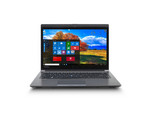Toshiba Portege Z30-C-16P
Specifications

Pricecompare
Average of 1 scores (from 1 reviews)
Reviews for the Toshiba Portege Z30-C-16P
Source: Notebooksbilliger Blog
 DE→EN Archive.org version
DE→EN Archive.org versionSingle Review, online available, Long, Date: 12/20/2016
Rating: Total score: 93% performance: 90% display: 90% mobility: 100%
Comment
Model:
With an ultra-thin, premium design that travels light and packed full of features to get work done anywhere, Toshiba’s Portege Z30-C-16P encompasses everything required for the businessmen to stay productive while on the move. Weighing at 1.2 kg, the Z30-C measures at 316.0 x 227.0 x 13.9 (front) / 17.9 (rear) mm (W x D x H), making it small enough to carry with ease. Despite its size, the ultrabook remains highly robust thanks to its durable but light magnesium alloy chassis. The size of the Z30-C’s display is quite large for an ultrabook. The 13.3-inch display is a non-reflective Full HD TFT High Brightness eDP display with LED backlighting and 16:9 aspect ratio. The size of the display also allows for 1920 x 1080 pixel resolution, with 166 PPI. For its base, the Z30-C has a full-size matt black backlit keyboard that illuminates a soft white glow, so users will not hurt their eyes while typing in the dark. The mechanics of the Chiclet-style keyboard also provides a pleasant typing experience, providing springy feedback with excellent travel. The clickpad has multi-touch control gestures supporting various scroll, zoom and launch functionalities, which are all customizable, many of which are already the standard in Windows 10. Alternatively, there is also a pointing stick (or AccuPoint, as Toshiba calls it) to mouse around. The Z30-C also comes with an enterprise-standard fingerprint scanner for an extra security measure.
The Z30-C offers a 6th generation Intel Core i7-6500U processor providing a lot of horse power packed into the slim machine, allowing the Z30-C to stand proudly alongside its price-point competitors. Modern games are playable with the on-board Z30-C’s Intel HD Graphics 520, but only at low settings and resolutions. That is hardly surprising since the Z30-C is not meant to be a gaming machine, but it is enough to satisfy casual gamers who occasionally indulge in some light gaming. Along with 16 GB of RAM, the Z30-C can crunch numbers, browse the web and carry out any other day-to-day tasks without any noticeable lag. In terms of port diversity, this is where the Z30-C truly shines. It is equipped with three USB 3.0 ports, one RGB port, one RJ-45 port, an HDMI port supporting 1080p signal format, an SD card slot and one headphone/microphone combo jack. The Z30 is one of the few ultrabooks prepared to interface directly with those not-quite-obsolete hardware, like projectors and hardwired Internet connections. At the heart of the Z30-C is a 4 cell Lithium-ion polymer battery that can impressively last up to 11 hours of usage on a single charge – pretty great for an ultrabook. On the memory front, the Z30-C features a 512 GB SSD. With premium looks and a respectable specs, the Toshiba Portege Z30-C-16P is a great choice for people in any professional field. Being a Portege also means that the price is slightly on the high point, like Lenovo’s Thinkpad series.
Hands-on article by Jagadisa Rajarathnam
Intel HD Graphics 520: Integrated GPU (GT2) with 24 EUs found on some Skylake CPU models (15 W ULV series).
Modern games should be playable with these graphics cards at low settings and resolutions. Casual gamers may be happy with these cards.
» Further information can be found in our Comparison of Mobile Graphics Cards and the corresponding Benchmark List.
Intel Core i7: The Intel Core i7 for laptops is based on the LG1156 Core i5/i7 CPU for desktops. The base clock speed of the CPUs is relatively low, but because of a huge Turbo mode, the cores can dynamically overclock to up to 3.2 GHz (920XM). Therefore, the CPU can be as fast as high clocked dual-core CPUs (using single threaded applications) but still offer the advantage of 4 cores. Because of the large TDP of 45 W / 55 W, the CPU is only intended for large laptops.
6500U: Skylake-based ULV dual-core processor for thin notebooks and ultrabooks. Offers an integrated HD Graphics 520 GPU and is manufactured in 14 nm.» Further information can be found in our Comparison of Mobile Processsors.
13.30":
There are hardly any tablets in this display size range anymore. For subnotebooks, on the other hand, it is the standard format.
The advantage of subnotebooks is that the entire laptop can be small and therefore easily portable. The smaller display also has the advantage of requiring less power, which further improves battery life and thus mobility. The disadvantage is that reading texts is more strenuous on the eyes. High resolutions are more likely to be found in standard laptops.
» To find out how fine a display is, see our DPI List.Toshiba: Toshiba Corporation is a Japanese conglomerate or technology group. The company was established in 1939 and in 1978 Toshiba became the official company name. The company's products and services include power, industrial and social infrastructure systems, elevators and escalators, electronic components, semiconductors, hard drives, printers, batteries, lighting, logistics and information technology. Toshiba was one of the largest manufacturers of personal computers, consumer electronics, home appliances and medical equipment.
93%: This rating is indeed excellent. There are not many models that are rated better. This can definitely be seen as a purchase recommendation.
» Further information can be found in our Notebook Purchase Guide.


 Deutsch
Deutsch English
English Español
Español Français
Français Italiano
Italiano Nederlands
Nederlands Polski
Polski Português
Português Русский
Русский Türkçe
Türkçe Svenska
Svenska Chinese
Chinese Magyar
Magyar